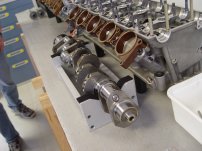Clive603
Titanium
- Joined
- Aug 2, 2008
- Location
- Sussex, England
Things got fairly exotic when it came to keeping roller bearing racing cranks together. Such as silver plating the cages to reduce friction. Something Norton also resorted to for their ferocious rotary racers which also had to make do with minimal doses of oil. One wonders how the modern DLC treatments from the likes of Bazers would fare under such duties.
Getting back to the 6 cylinder crank the big worry is effects due to rocking couples which are considerably magnified in an over constrained system like a seven bearing crank. Although a straight six is theoretically intrinsically in balance the actual complementing forces are spread out along the crank. Essentially you have a pair of in-line threes, one at the front and one at the back, rocking about the point where they join. The centre main bearing. All sorts of horrible loading going on once you run faster than the first critical frequency unless proper attention is paid to what's happening. Correctly disposed and sized counterweights significantly reduce the residual forces. Which is why you mustn't take out too much weight as that actually increases the loadings.
Jims R90 BMW racers being a classic example of that. With the big plain bearings front and rear the R90 motor is functionally a pair of overhung crank singles joined by a single web. So the rocking forces want to go through the web. Trimming off the weight to balance it like twin instead of a pair of connected singles was asking for trouble.
Even numbers of cylinders firing at even intervals spread out on a long crank have frequently been somewhat problematic. One reason why the X format aero engines never really worked. The 24 cylinder Rolls Royce Vulture would actually jack the crankcases apart once they'd managed to persuade it not to snap cranks. One master and three slaves as a con-rod arrangement was probably not a good idea either as the extra vibrations are, ahem, "complex". Maybe Napiers had the right idea with the Cub, a 16 cylinder 1,000 hp monstrosity designed in 1919 with upper banks at 52.5° spacing and the other two following at 90° and 127.5° intervals. Which could charitably be described as lopsided. Despite which it worked well enough but no-one in those days really had a use for 1,000 hp in a 3,500 lb package. When it comes to Napier I've always had a sneaking suspicion that the design office had an "all you can smoke" pot of whacky-baccy so they could fill their pipes for free. Hard to argue with the power outputs but the means of getting there tended to "odd" and beyond.
Clive
Getting back to the 6 cylinder crank the big worry is effects due to rocking couples which are considerably magnified in an over constrained system like a seven bearing crank. Although a straight six is theoretically intrinsically in balance the actual complementing forces are spread out along the crank. Essentially you have a pair of in-line threes, one at the front and one at the back, rocking about the point where they join. The centre main bearing. All sorts of horrible loading going on once you run faster than the first critical frequency unless proper attention is paid to what's happening. Correctly disposed and sized counterweights significantly reduce the residual forces. Which is why you mustn't take out too much weight as that actually increases the loadings.
Jims R90 BMW racers being a classic example of that. With the big plain bearings front and rear the R90 motor is functionally a pair of overhung crank singles joined by a single web. So the rocking forces want to go through the web. Trimming off the weight to balance it like twin instead of a pair of connected singles was asking for trouble.
Even numbers of cylinders firing at even intervals spread out on a long crank have frequently been somewhat problematic. One reason why the X format aero engines never really worked. The 24 cylinder Rolls Royce Vulture would actually jack the crankcases apart once they'd managed to persuade it not to snap cranks. One master and three slaves as a con-rod arrangement was probably not a good idea either as the extra vibrations are, ahem, "complex". Maybe Napiers had the right idea with the Cub, a 16 cylinder 1,000 hp monstrosity designed in 1919 with upper banks at 52.5° spacing and the other two following at 90° and 127.5° intervals. Which could charitably be described as lopsided. Despite which it worked well enough but no-one in those days really had a use for 1,000 hp in a 3,500 lb package. When it comes to Napier I've always had a sneaking suspicion that the design office had an "all you can smoke" pot of whacky-baccy so they could fill their pipes for free. Hard to argue with the power outputs but the means of getting there tended to "odd" and beyond.
Clive




